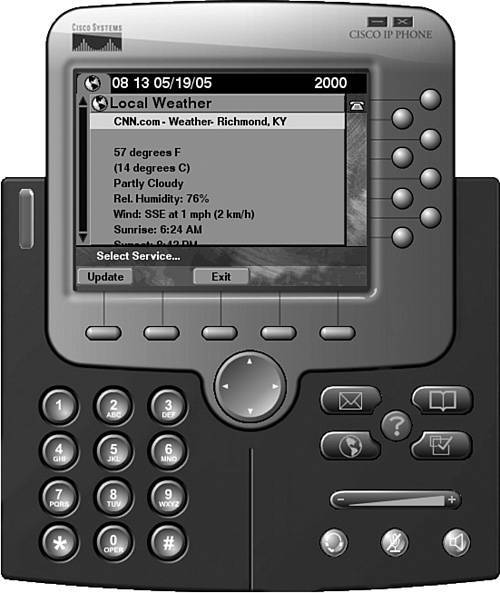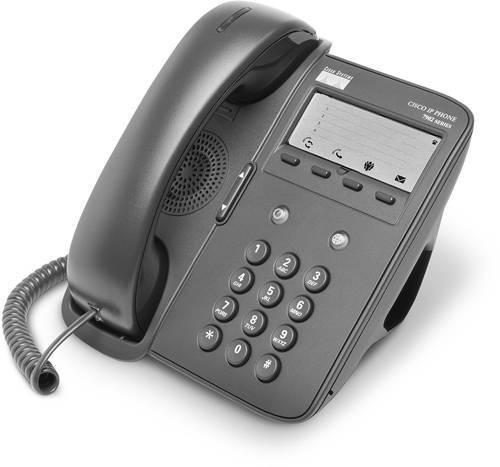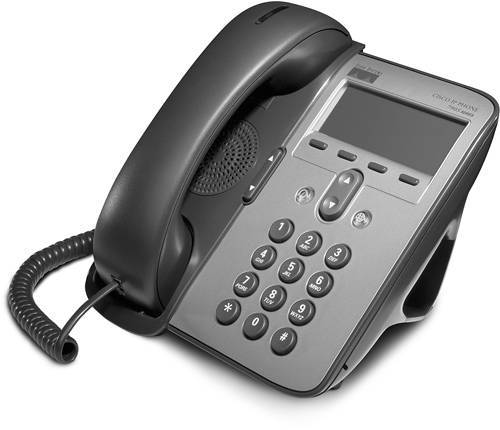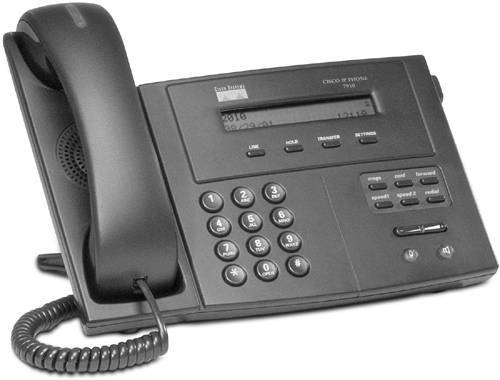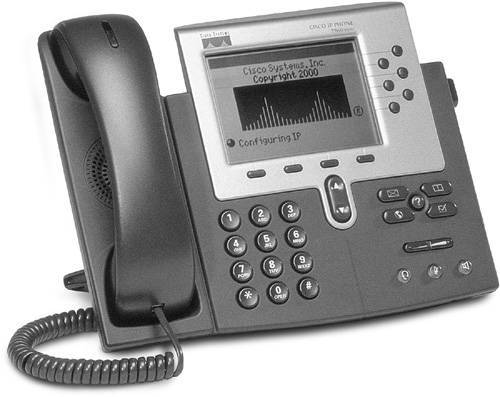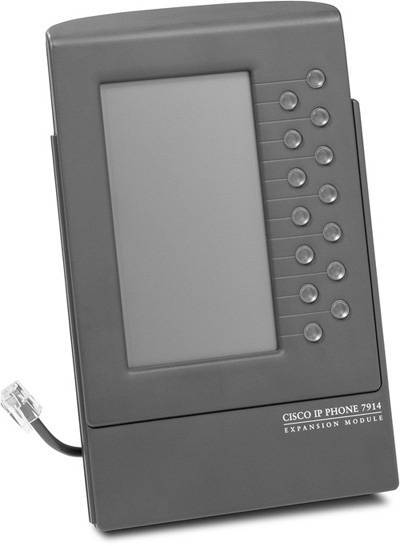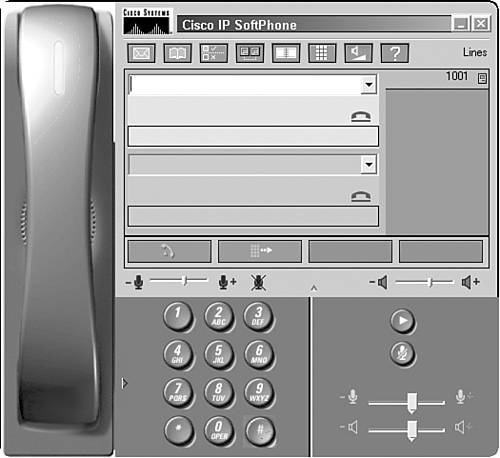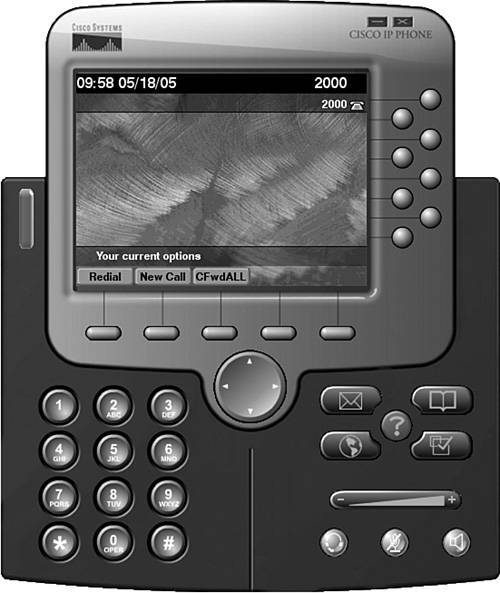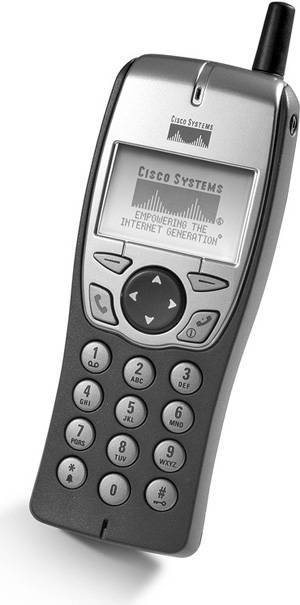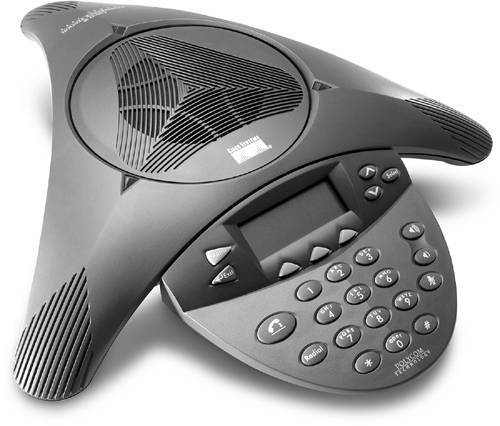Replacing Old Phones with IP Phones
| One of the first things a company's users notice after a migration to IP telephony is the cool new phone sitting on their desk. Cisco IP Phones come in a variety of shapes and sizes, and these IP phones come with a plethora of features. When an IP phone boots up, the phone learns what virtual LAN (VLAN) it belongs to (that is, the voice VLAN) via a Cisco Discovery Protocol (CDP) message sent from the switch to the IP phone. The IP phone then sends out a Dynamic Host Configuration Protocol (DHCP) request, asking a DHCP server for an IP address that the IP phone can use. The DHCP server responds with not only the IP phone's IP address, but also subnet mask information, default gateway information, and the address of a Trivial File Transfer Protocol (TFTP) server. The IP phone needs the address of the TFTP server because the TFTP server contains the IP phone's configuration file. The configuration file contains such information as a listing of up to three CCM servers the IP phone can register with. The IP phone downloads its configuration file from the TFTP server and registers with a CCM server from the configuration file's listing of CCM servers. The IP phone can now place and receive calls. Although Cisco continually introduces new IP phone models, to establish a frame of reference, consider some of the features to look for in Cisco IP Phones. Inline PowerJust like an analog phone needs -48 volts of direct current (VDC), a Cisco IP Phone also requires -48 VDC to power up. Cisco IP Phones can be powered in one of three ways:
The IEEE 802.3af standard describes how inline power, sometimes called Power over Ethernet (PoE), functions. However, Cisco developed its own proprietary inline power approach prior to the IEEE 802.3af standard. Modern Cisco IP Phones support both the Cisco prestandard inline power approach and IEEE 802.3af. Let's consider both inline power implementations:
Some Cisco Catalyst switches/router switch modules only support the Cisco prestandard proprietary approach, while some Catalyst switches support both the Cisco prestandard approach and the IEEE 802.3af standard, as shown in Table 4-4.
CODECsCODECs (coder decoders) take analog voice waves and convert them into binary 1s and 0s. All Cisco IP Phones support the G.711 CODEC. G.711 does not compress the voice (that is, reduce the amount of bandwidth required for voice). Rather, G.711 simply converts analog waves into binary using pulse code modulation (PCM). High-speed LANs commonly use G.711 because the 64 kbps of bandwidth for voice payload required by G.711 presents an insignificant bandwidth impact on the LAN. However, on the relatively slow-speed WAN, just a few G.711 calls might quickly eat up the available bandwidth. Therefore, you typically use the G.729 CODEC on WAN connections. G.729 only requires 8 kbps of bandwidth for voice payload. Second-generation Cisco IP Phones (that is, the Cisco IP Phones on the market today) support both G.711 and G.729. However, you might encounter an older first-generation Cisco IP Phone, such as the 12SP+ or 30VIP phone models. These first-generation phones support G.723, as opposed to G.729. G.723, like G.729, compresses the voice packets to preserve bandwidth, and G.723 only requires 6.3 kbps of bandwidth for the voice payload. However, G.723 suffers from more voice quality degradation than G.729. As a result, Cisco decided to only offer the G.711 and G.729 CODECs in current IP phone models. To be technically accurate, Cisco IP Phones use a variant of G.729, called G.729a. The "a" variant reduces the processor overhead required to compress voice samples. Additional Switch PortSuppose you want to place IP phones on the desktops of users in a cubicle environment. A single Ethernet connection currently runs to each of these cubicles for PC connections. However, if you install an IP phone in each cubicle, two devices (that is, the IP phone and the PC) now need connectivity back to the wiring closet. Do you have to run an additional Ethernet wire from the wiring closet to each cubicle? Maybe not. Some Cisco IP Phones contain an Ethernet switch port, allowing you to connect a PC to the IP phone and then connect the IP phone back to the wiring closet, as shown in Figure 4-13. As a result, a single, and hopefully existing, Ethernet connection can serve both a PC and a Cisco IP Phone. An IP phone containing an additional switch port acts as a three-port switch, with one port connecting to the internals of the IP phone, one port connecting to the wiring closet switch, and one port allowing a PC connection into the phone. Figure 4-13. Additional Switch Port on IP Phone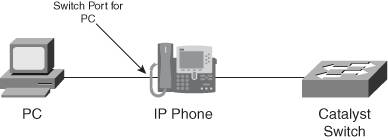 XML SupportExtensible Markup Language (XML) offers an alternative method of sending text and pictures over a network, as opposed to the Hypertext Markup Language (HTML) we're accustomed to when viewing web pages from the Internet. Some Cisco IP Phones contain liquid crystal display (LCD) screens that display XML pages. Users can interact with these XML pages using the buttons on IP phones. Examples of XML applications I've seen on Cisco IP Phones include
As another example, you can even retrieve weather reports from a Cisco IP Phone using an XML application, as shown in Figure 4-14. Figure 4-14. XML Application Example Weather Report Auxiliary VLANIf an IP phone contains an extra Ethernet port (used to connect a PC to the IP phone), both data and voice traffic flow over the Ethernet cable to the wiring closet switch. Cisco IP Phones can send the voice packets in one VLAN (that is, the voice VLAN or the auxiliary VLAN) and data packets in a separate VLAN (that is, the data VLAN), as shown in Figure 4-15. Figure 4-15. Auxiliary VLAN When an Ethernet connection carries traffic for more than one VLAN, we call that connection a trunk. The technical name for the type of trunk set up between the IP phone and the wiring closet switch is an IEEE 802.1Q trunk, meaning that the type of trunk is an industry standard and not Cisco proprietary. SoftkeysCisco IP Phones support so many features (for example, hold, transfer, conference, etc.) that an IP phone with a specific button for every feature would be massive. Fortunately, many Cisco IP Phones support softkeys, which serve different functions at different times. For example, when an IP phone is on-hook, a particular softkey might act as a Redial key, while the very same button might act as a Hold key when the IP phone is off-hook. Line/Speed Dial ButtonsMany users need more than a single line on their phone. These users need to handle multiple incoming calls, perform call transfers, and set up conference calls. Therefore, some models of Cisco IP Phones offer multiple line buttons, where each button can represent a different extension number. However, let's say a user's IP phone has six buttons that can be used for line buttons, but the user only needs two line buttons. In that case, the four remaining buttons can serve as speed dial buttons. A caller can lift an IP phone's handset and press a speed dial button to dial a preconfigured number. note
Either the Cisco CallManager administrator or a user can configure a phone's speed dial buttons. By empowering users to make their own speed dial modifications, administrators are not burdened, for example, with making changes every time someone gets a new boyfriend or girlfriend. Now that you know some of the bells and whistles to look for when selecting a Cisco IP Phone, let's reinforce this discussion by examining a few specific Cisco IP Phone models. Cisco 7902GThe Cisco 7902G IP Phone, as shown in Figure 4-16, serves as an entry-level IP phone. Because the 7902G acts as a single line phone and because it lacks many of the higher-end features (for example, softkeys and an extra Ethernet switch port) present in some IP phones, the 7902G might be appropriate for a company's break room. The Cisco 7902G offers the following characteristics:
Figure 4-16. Cisco 7902G IP Phone Cisco 7905G and 7912GThe Cisco 7905G and 7912G, as shown in Figure 4-17, are entry-level Cisco IP Phones offering similar features. The 7905G and 7912G differ in one feature, however. The 7912G contains an extra Ethernet switch port, allowing a PC to connect directly into the 7912G. The features offered by these phones include Figure 4-17. Cisco 7905G/7912G IP Phone
Cisco 7910G+SWThe Cisco 7910G+SW, as shown in Figure 4-18, serves as an entry-level Cisco IP Phone. Like other entry-level Cisco IP Phones, the 7910G+SW offers basic functions commonplace in common-use areas within a company. Cisco 7910G+SW features include Figure 4-18. Cisco 7910G+SW IP Phone
Cisco 7940G and 7960GThe Cisco 7940G and 7960G IP phones, as shown in Figure 4-19, feature multiple line/speed dial buttons. Unlike the entry-level phones previously described, the 7940G and 7960G contain a large LCD display, which allows a caller to interact with XML applications. The 7960G offers the same features as the 7940G, with one exception. The 7960G contains six line/speed dial buttons, as opposed to the 7940G's two line/speed dial buttons. 7940G and 7060G features include Figure 4-19. Cisco 7960G IP Phone
If you require additional line/speed dial buttons for a 7940G or 7960G IP phone, you can purchase the Cisco 7914 Expansion Module, as shown in Figure 4-20. The 7914 adds 14 additional buttons, which can be used as either line or speed dial buttons. In fact, two 7914s can be added to a 7940G or 7960G IP phone, giving you 28 additional buttons at your disposal. However, you need to purchase a power brick for each 7914, because the 7914s do not support inline power. Figure 4-20. Cisco 7914 Expansion Module Cisco 7970G and 7971G-GECisco introduced a color display in its 7970G IP phone model, as shown in Figure 4-21. Users can interact with XML applications via the color display's touch screen feature. Cisco recommends the 7970G for executives and decision makers. Figure 4-21. Cisco 7970G IP Phone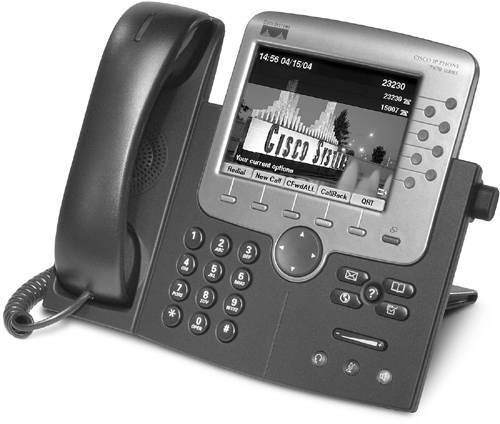 Did you ever watch the NBC TV show Las Vegas? If so, you probably saw a 7970G sitting on Big Ed Deline's desk, with a big red Montecito logo on the phone's display. An updated version of the 7970G, the 7971G-GE contains a gigabit Ethernet switch port allowing a PC with a gigabit network interface card to plug into the IP phone, as compared to the 10/100 Mbps Ethernet switch port on the 7970G. Other than the different Ethernet switch port interface speed, the 7970G and 7971G-GE have identical features. Specifically, these IP phones feature:
Cisco IP SoftPhoneCisco offers software-based IP phones, which allow a user to install software on their laptop, as an example, and carry their laptop (and therefore their IP phone) from location to location. The user simply connects their laptop into a network connection at any company site, customer site, or even a broadband Internet connection in a hotel, and the user can make and receive calls over their software-based IP phone using a USB headset connected to the laptop. Although Cisco offers a couple software-based IP phones, it first introduced the Cisco IP SoftPhone, as shown in Figure 4-22. The Cisco IP SoftPhone offers the following features and characteristics:
Figure 4-22. Cisco IP SoftPhone Cisco IP CommunicatorIn addition to the Cisco IP SoftPhone, Cisco also offers the Cisco IP Communicator as a software-based IP phone. Like the Cisco IP SoftPhone, the Cisco IP Communicator installs on a laptop or PC, allowing the user to take their IP phone with them from location to location. However, the Cisco IP Communicator, as shown in Figure 4-23, reflects the look and feel of a hardware-based IP phone (that is, the 7970G IP phone) more so than the Cisco IP SoftPhone. The Cisco IP Communicator offers the following features and characteristics:
Figure 4-23. Cisco IP Communicator Cisco 7920Many laptop computers today contain wireless network adapters, allowing a user to carry the laptop with them while still maintaining connectivity to a network. In the past few years, wireless technologies have found their way into many libraries, hotels, and airports around the country, and today wireless technology is springing up in some of the most unlikely places. For example, I recently connected to a wireless network at a bookstore and in a restaurant. However, wireless technology (that is, IEEE 802.11b) isn't limited to PCs. Cisco now offers a wireless IP phone. This phone is not a "cordless" phone, as you might have in your home. The Cisco 7920 IP Phone, as shown in Figure 4-24, uses the same wireless technology your laptop uses to connect to wireless access points, allowing you to conduct untethered IP phone conversations. The 7920 boasts the following features:
Figure 4-24. Cisco 7920 Wireless IP Phone Cisco 7936Have you ever sat in a conference room and seen one of those big speakerphones (looking much like a spaceship) sitting in the middle of the conference room table? Those conference room speakerphones contain circuitry optimized for picking up multiple voices around the table. Cisco partnered with Polycom, a leading manufacturer of conference room speakerphones, to produce an IP telephony version of the Polycom speakerphone. Specifically, the Cisco IP Conference Station 7936 replaces a company's traditional conference room speaker-phone. The 7936, as shown in Figure 4-25, offers the following features:
Figure 4-25. Cisco IP Conference Station 7936 |
EAN: 2147483647
Pages: 138

